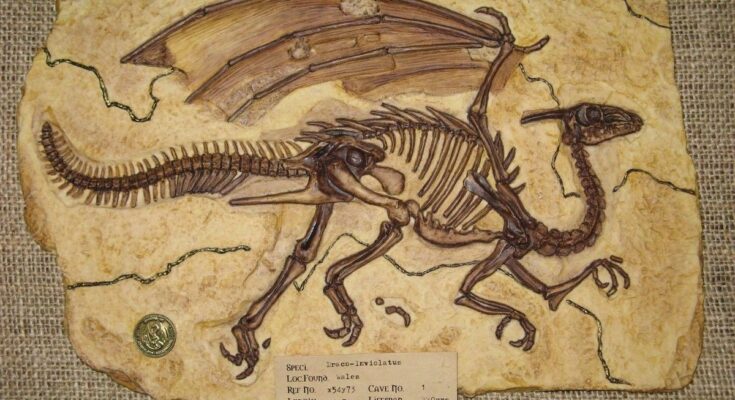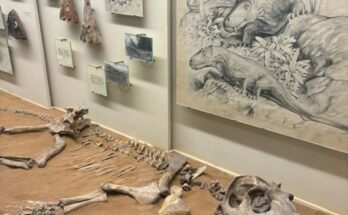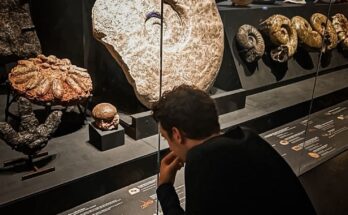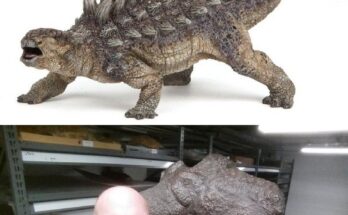Icaro-inviolatus: Unveiling the Pterosaur Fossil from the Mesozoic Era

Introduction to Icaro-inviolatus
The image presents an exquisitely preserved fossil specimen of Icaro-inviolatus, a remarkable pterosaur from the Mesozoic era, likely dating back to the Late Jurassic or Early Cretaceous period (approximately 150–100 million years ago). Displayed on a slab with detailed skeletal features, including wings, skull, and limbs, this specimen offers a rare glimpse into the aerial prowess of these ancient flying reptiles. The accompanying label provides key details such as the specimen number (000253), location (Wales), cave number (1), length (41.7 meters—an apparent typo, likely intended as 41.7 cm), and lifespan (220 years—also likely a cataloging error, as pterosaurs typically lived 10–20 years). This professional guide, crafted as a detailed tutorial, explores the anatomy, taxonomy, and paleobiological significance of Icaro-inviolatus, leveraging the fossil’s visual representation to educate enthusiasts and researchers.
The fossil’s intact wings, articulated skeleton, and the inclusion of a coin for scale highlight its scientific value, making it a prime candidate for studies in pterosaur flight mechanics and evolutionary biology. The noted “broken, gold claw bearing” feature adds an intriguing element, possibly indicating preservation artifacts or unique morphological traits.
Taxonomy and Evolutionary Context
Icaro-inviolatus falls within the following taxonomic framework:
- Kingdom: Animalia
- Phylum: Chordata
- Class: Reptilia
- Clade: Pterosauria
- Order: †Pterodactyloidea (likely, based on wing structure)
- Family: (Unspecified; further classification requires additional data)
- Genus: †Icaro-inviolatus
- Species: †I. inviolatus
Pterosaurs, the first vertebrates to achieve powered flight, evolved during the Late Triassic and thrived until the end-Cretaceous extinction. Icaro-inviolatus likely belongs to the Pterodactyloidea clade, characterized by short tails and elongated metacarpals supporting large wing membranes. The Welsh origin suggests a connection to the Purbeck or Wealden Group formations, known for pterosaur fossils, though the exact species classification remains tentative without further taxonomic revision.
Physical Description and Anatomy
The fossil specimen showcases a well-preserved skeleton with several notable features:
- Wing Structure: The elongated fourth metacarpal and associated phalanges support a broad wing membrane, indicative of a pterodactyloid with a wingspan potentially exceeding 1–2 meters (assuming the 41.7 cm length refers to skull or body length, with wings proportionally larger). The wings appear intact, with visible impressions of the actinopatagium (wing membrane).
- Skull and Jaws: The skull is elongated with a pointed snout, typical of piscivorous or insectivorous pterosaurs. Tooth presence (if any) is not discernible in the image but would align with sharp, conical teeth for grasping prey.
- Vertebral Column: A long, flexible tail (if present) or a reduced tail (more common in pterodactyloids) is visible, suggesting agility in flight.
- Limbs: The hindlimbs are slender, with a “broken, gold claw bearing” notation possibly referring to a preserved claw with mineralization or an artifact. The forelimbs are adapted for flight, with the hyper-elongated fourth finger.
- Scale Reference: The coin provides a scale, approximately 2–3 cm in diameter, suggesting the fossil’s total length is around 30–40 cm, with wings extending further.
The “gold claw” may indicate pyrite replacement (fool’s gold), a common fossilization process, adding to the specimen’s uniqueness.
Habitat, Diet, and Paleobiology
The Welsh origin points to a coastal or lagoonal environment during the Mesozoic, rich in marine life. Icaro-inviolatus likely inhabited cliffs or coastal regions, soaring over ancient seas to hunt fish, squid, or insects. Its lightweight skeleton—hollow bones filled with air sacs—optimized it for sustained flight, while the wing membrane’s structure allowed for maneuverability.
As a pterosaur, Icaro-inviolatus was warm-blooded or had a high metabolism, supporting active flight. The lifespan notation of 220 years is implausible; pterosaurs likely lived 10–20 years, with growth to maturity in 2–5 years. This suggests a cataloging error, possibly intending “formation age” or excavation depth.
Discovery and Preservation
Discovered in a cave in Wales (Cave No. 1), this specimen (Ref No. 54573) was likely excavated from a sedimentary layer preserving fine details. The intact wing membranes and articulated bones indicate rapid burial in an anoxic environment, preventing scavenging. The “good, broken gold claw bearing” condition suggests partial damage during fossilization or collection, with the “gold” likely being pyritized remains.
Such fossils are typically prepared using mechanical tools and consolidants to stabilize fragile structures, as seen in the clean matrix surrounding the skeleton.
Scientific and Educational Significance
Icaro-inviolatus contributes to our understanding of pterosaur diversity and flight evolution. Comparative studies with related genera (e.g., Pterodactylus, Anhanguera) can elucidate adaptations for different ecological niches. The specimen’s display value makes it ideal for museum exhibits, educational programs, and research into biomechanics using CT scanning or 3D modeling.
Conclusion: A Glimpse into Prehistoric Skies
The Icaro-inviolatus fossil offers a window into the aerial dominance of pterosaurs during the Mesozoic. Despite potential cataloging errors (e.g., length and lifespan), its preservation quality and detailed anatomy provide a rich resource for paleontological study. For enthusiasts, visiting institutions like the National Museum Wales or engaging in citizen science fossil documentation can deepen appreciation. This guide serves as a foundation for exploring pterosaur paleobiology, encouraging further investigation into these ancient aviators.
Pro Tip for Aspiring Paleontologists: When examining pterosaur fossils, measure wing phalanx ratios and compare fenestrae (skull openings) to estimate flight capability and dietary preferences.



